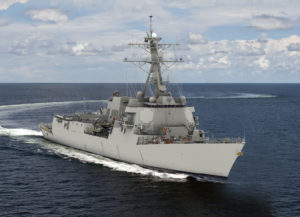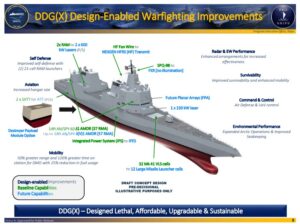Last week the Chief of Naval Operations (CNO) said the limited American industrial capacity is the biggest barrier to growing the fleet as much as the Navy wants over the coming decades.
“So we have an industrial capacity that’s limited. In other words, we can only get so many ships off the production line a year, my goal would be to optimize those production lines for destroyers, for frigates, for amphibious ships, for the light amphibious ships, for supply ships,” Adm. Mike Gilday said during a Heritage Foundation event on Aug. 25.

Gilday specified the Navy needs to send a demand signal to industry “that we need to get to three destroyers a year instead of 1.5, that we need to maintain two submarines a year. And so part of this is on us to give them…a clear aim point so that they can plan a workforce and infrastructure that’s going to be able to meet the demand.”
However, he underscored no industry would make those level of investments without a higher degree of confidence than they currently have.
“That’s what we’re trying to round that curve, to put us in a place where we’re producing those lethal, capable ships that we need the most.”
Last month, Gilday released his latest Navigation Plan that recommended the Navy move toward over 350 manned vessels by 2045, including 12 Columbia-class ballistic missile submarines, 12 aircraft carrier, 66 fast-attack submarines and large payload submarines, 96 large surface combatants like the Arleigh Burke-class destroyer and future DDG(X) follow-on, 56 small surface combatants like the Littoral Combat Ship and Constellation-class frigate, 31 amphibious assault ships, 18 Light Amphibious Warships, 82 logistics ships and auxiliary vessels, and up to 150 unmanned vessels (Defense Daily, July 26).
Likewise, the Navy’s 30-year shipbuilding plan, delivered in April, outlined three fleet options to Congress, dependent on budgeting. Two assume flat line budgets that reach 318-322 ships by 2045 and a third assuming $75 billion in real growth starting in five years to reach 363 ships by 2045 (Defense Daily, April 20).
In Navy FY ‘23 budget request documents published in April, the Navy requested authority for another Multi-Year procurement Contract for FY ‘23 – ‘27 for nine more Arleigh Burke-class destroyers, with an option for a 10th vessel. The Navy is planning to buy two per year from FY ‘23 to ‘27 and another two thereafter to purchase 101 destroyers total (Defense Daily, April 26).
The service plans to ultimately have a good transition from the current DDG-51 Flight III destroyers to the future DDG(X) successor vessel, almost certainly using the same current shipbuilders: General Dynamics’ Bath Iron Works (BIW) [GD] and HII’s Ingalls Shipbuilding [HII].

However, FY ‘23 congressional defense budget bills are pushing further to a third destroyer in FY ‘23 and a multi-year contract that would allow the Navy to buy up to 15 destroyers over five years rather than 10.
The House Armed Services Committee approved an amendment in its FY ‘23 defense authorization bill that would increase the total topline and allow the Navy to have a contract for up to 15 destroyers.
Currently BIW and Ingalls produce about one destroyer per year each, but under this scheme they would increase production to 1.5 destroyers each per year.
Last month, a White House Statement of Administration Policy said it “strongly opposes incrementally funding a third Arleigh Burke class destroyer in FY 2023” (Defense Daily, July 12).